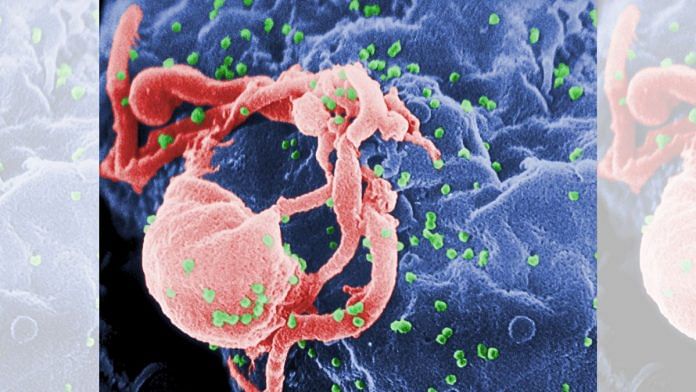New Delhi: A new dual gene editing therapy eliminates HIV infections by targeting not only the HIV-1 virus, but also the CC chemokine receptor 5 (CCR5), a protein found on the surface of white blood cells and other cells involved in signalling and coordination of immune responses in the human body, a study has found. CCR5 plays a key role in enabling the HIV-1 virus to enter human cells.
Undertaken by researchers from two US universities, the Lewis Katz School of Medicine at Temple University and the University of Nebraska Medical Center (UNMC), the study was published in the journal Proceedings of the National Academy of Sciences Tuesday.
Kamel Khalili, a researcher from Lewis Katz School of Medicine and Howard E. Gendelman of the University of Nebraska Medical Center, were senior investigators in the study.
It is reportedly the first study which combines a dual gene-editing approach with antiretroviral drug therapy, commonly used to treat HIV infections.
Following reports of three patients being cured of HIV infections by a combination of antiretroviral drug therapy and the use of bone marrow transplantation, commonly employed in treating leukemia, the researchers focused on studying the importance of the inactivation of the CCR5 mutation by removing the HIV-1 DNA from the body of the infected person.
CCR5 is an anchoring protein for the HIV-1 virus, the most common type of Human Immunodeficiency Virus (HIV), and has a critical role in accelerating the infection.
The researchers found that when the gene editing technology known as Clustered Regularly Interspaced Short Palindromic Repeats (CRISPR) was administered to mice engrafted with human T cells (a type of white blood cells), it resulted in suppression of the virus and elimination of HIV-1 in 58 per cent of infected animals, at 17 weeks after infection.
According to the study’s authors, HIV-1 was not detected in the lymphoid system, bone marrow or central nervous system of the mice that received the combination of antiretroviral therapy and CRISPR editing.
“Dr. Khalili’s team generated the essential gene-editing constructs, and we then applied those constructs in our LASER-ART mouse model at Nebraska, figuring out when to administer gene-editing therapy and carrying out analyses to maximise HIV-1 excision, CCR5 inactivation, and suppression of viral growth,” Dr. Gendelman, MD, professor and chair of the department of pharmacology and experiential neuroscience at the University of Nebraska Medical Center, said in a statement.
The Temple University team now plans to test the dual gene-editing strategy in non-human primates.
Also read: Genetic code inherited from Neanderthals increases severe Covid risk but protects from HIV
‘A simple and inexpensive approach’
Researchers have previously proved that HIV can be removed from the genomes of live, HIV-infected mice, curing some of them. For this they had used the CRISPR gene-editing technology and combined it with a therapeutic strategy known as long-acting slow-effective release antiretroviral therapy (LASER ART).
LASER ART could reduce, but not get rid of the virus completely. The researchers found that the virus could eventually recur from the tissue reservoirs of the mice and cause a rebound infection.
This could be because HIV integrates itself into the genomes of host cells, which is why sometimes it can lie dormant in tissue reservoirs, away from the reach of ART drugs. This has previously been observed in humans as well, where a rebound infection occurs after a sudden cessation of ART.
In order to tackle any rebounds, the Temple University team developed a novel CRISPR technology for HIV excision, which is essentially a dual system that allows for the permanent elimination of the virus by also targeting the CCR5 receptor.
During the procedure, the CRISPR gene editing molecule was simply applied to the mouse models through intravenous inoculation, or the insertion of a needle in a vein. This time, no viral rebound was observed in the mice, which was verified 11 weeks after ART was ceased.
The strategy stands out for a few other reasons as well.
According to the researchers, the CRISPR gene-editing approach is comparatively inexpensive and simple. It has also previously been used to alter immune cells so that they can recognise mutated proteins specific to a person’s tumours, in order to treat cancer.
“The type of bone marrow transplant that has brought about cures in humans is reserved for patients who also have leukemia. It requires multiple rounds of radiation and is not applicable in resource-limited regions, where HIV infection tends to be most common,” said Dr. Khalili in a statement.
(Edited by Nida Fatima Siddiqui)
Also read: 4 patented HIV, hepatitis & TB drugs now on govt price control list. Controversial ranitidine cut



